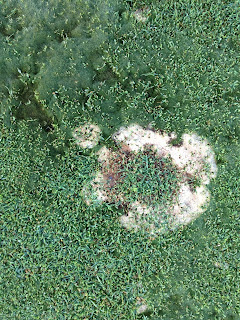This
spring, as you all know, brought large amounts of rainfall to central Iowa.
This was a blessing for most including us the Horticulture Research Station.
The water level in the pond returned to its maximum height, soil moisture
reached great depths, and reduced the amount water needed to irrigate. The
record breaking rainfalls also encouraged moss growth on one of our putting
greens. Over the years, we have tried to encourage this growth to continue
research on moss controls.
A couple of weeks ago, I noticed spots on the green that appeared to look like dollar spot, however, the spots were only covering the moss and not the bentgrass. I decided to leave the area untreated to see if these spots would continue to spread or remain localized. Within a few short weeks, the disease spread like wildfire across the moss. A sample was taken to the Disease Diagnostic Clinic here at Iowa State University. The pathogen was identified as Sclerotium rolfsii.
Sclerotium
rolfsii is a fungal disease that has an extensive host range that targets
over 500 species. It is very common in the tropics, subtropics, and other warm temperature
regions. However, it is very rare to see the disease this far north. The pathogen rarely occurs when winter temperatures fall below 32˚F.
The disease survives in the form of sclerotia. These sclerotia are easily
spread by foot traffic and mowing equipment. Most of the research articles that
I have read state that control is relatively difficult to achieve. We will
continue to monitor the area and post any updates on the control.



No comments:
Post a Comment